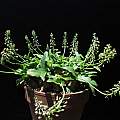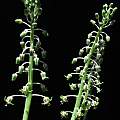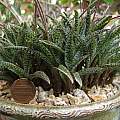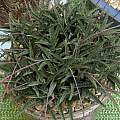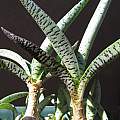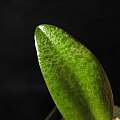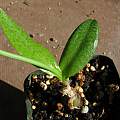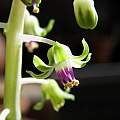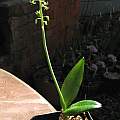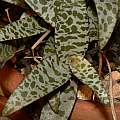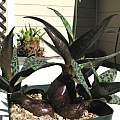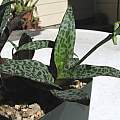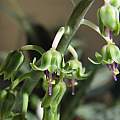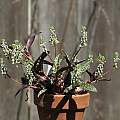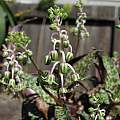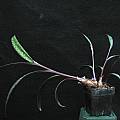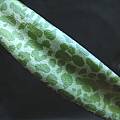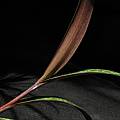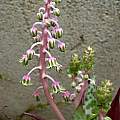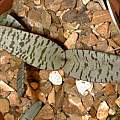Ledebouria socialis (syn. Ledebouria violacea, Scilla socialis, Scilla violacea) is one of the most widely cultivated bulbs, favored by cactus and succulent growers. It is found in fine to medium grained shallow to deep well drained humus rich sandy soil in the transition zone between the Eastern and Western Cape. It usually grows in shade mostly in closed evergreen woodland. A few populations occur in evergreen scrub forest. J. S. Jessop, in African Bot. 36:253 (1970) lumped the various described forms into a single species with small epigeal (exposed) bulbs, erect inflorescences with small flowers and strongly reflexed tepals. He considered the basic green mottled, and silvery mottled leaf forms to be of the same species.
Common names are "silver squill" and "wood hyacinth". The species was first described by John Gilbert Baker as Scilla socialis in 1870 and was put into the genus Ledebouria by Jessop in 1970.
Cultivation of this species is easy. Pot 2/3 of the bulbs exposed above a well drained soil mix (1:1 organic:inorganic, although 2:1 organic inorganic also works well). Give the plants filtered sunlight and never full sun. During the summer growing season, give the plants plenty of water and occasional fertilizer. The plants will not suffer from winter water although it is recommended that they be given a dry dormancy. In many varieties, a wet winter dormancy causes the plants to continue growing without replacing the old leaves. When spring and summer arrives, the plant does not put out a new flush and will not flower.
The dramatic variations in leaf colors and patterns has led to much confusion in both taxonomic and horticultural circles. Even now, there are few available published selection/cultivar names of this species. In an effort to organize this species and its variation based wholly from a horticultural standpoint, new cultivar names are published here. These names should reflect the names previously published elsewhere. Information provided by Nhu Nguyen.
Ledebouria socialis 'Juda' is the variegated form of the species. The margins of the leaves are variegated with either light yellow or pink bands with light green spots. The center of the leaves remain silver with darker green spots. The back of the leaves are pink to pastel violet.
Ledebouria socialis 'Laxifolia' (sensu J. G. Baker 1897). Baker described this form as Scilla laxifolia from a plant cultivated at the Royal Botanic Gardens, Kew. The bulbs are globose, 1.5in (about 4 cm) in diameter, leaves are pale green, mottled with darker green, oblong-lanceolate, up to 3in (about 7.5 cm) long. The cultivar name refers to the flaccid or "slack" of the leaves. The photos were taken by Nhu Nguyen.
Ledebouria socialis 'Miner' is a dwarf selection from M. Vassar, HBG 73608. It was called L. socialis 'Minor', but was renamed by John Trager as "Miner" to reflect the "plant's dwarf stature and the horticultural process of selection in search of worthy cultivars" (Trager 2004). The photos below were taken by Nhu Nguyen. Photos 1-2 were taken at the San Francisco Cactus and Succulent Show, 2011.
Ledebouria socialis 'Paucifolia' (sensu J.G. Baker 1870). This plant can be found under the name Ledebouria "pauciflora" or sometimes Ledebouria "paucifolia". It most likely came from "Scilla (Ledebouria) paucifolia" (Baker, Refug. Bot. 3:t.181, 1870). Neither of these names are validly published and plants grown under these name were synonymized with L. socialis (Jessop 1970). Bulbs are ovoid, gregariously divided above the ground, slightly scaly; leaves 2, rarely 3, fleshy herbaceous, horizontal patulate, oblong-lanceolate, pallid with strong glaucous green spots; scape flexible coming out of the leaves, raceme loose with 20-30 flowers, pedicels twice as long as the flowers, tepals 6 mm long white-green, with the base with little or no purple tint, filament 3/4 length of the tepals, with the distal (tips) purple, the base a little widened. As the name implies, the leaves of this cultivar seems to be shorter than others. Bulbs grow completely above the soil and multiply readily. Both bulbs and leaves grow slower than the 'Violacea' form. A dry-ish winter dormancy is usually necessary to induce the plants to bloom in spring. Photos by Nhu Nguyen.
Ledebouria socialis 'Violacea' is one of the most commonly cultivated forms of the species. Tjaden (1989) segregated this form based on leaf coloration as Ledebouria violacea. The upper surface of the leaves are silver with green spots and the lower surface is a maroon violet. Coloration, leaf length, and overall compaction depends on cultivation conditions. This form must be given a dry-ish winter dormancy otherwise blooming during the following year won't be very good and the old leaves will not be renewed, giving the plant a raggy appearance. Photo 1 was taken by David Fenwick and photos 2-6 were taken by Nhu Nguyen. Photos 2-4 show plants growing in high light.
Photos 1-3 below from Nhu Nguyen are of plants growing in a more shady condition, causing some leaf etiolation. Photo 4 was taken by Cameron McMaster and shows a form found near the Keiskamma River.
Ledebouria socialis 'Zebrina' (sensu Stephen Jankalski) has been called Scilla violacea var. nana as a horticultural name. The upper surface of the leaves are silvery with darker horizontal (transverse) stripes. It is aptly called 'Zebrina'. The photo below was taken by David Fenwick.
